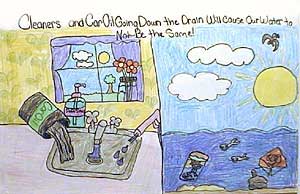|
 
Earth  Environmental
Education Environmental
Education  Nonpoint Source Pollution: What To Do
Nonpoint Source Pollution: What To Do
WHAT YOU CAN DO TO REDUCE POLLUTED RUNOFF (NONPOINT
SOURCE POLLUTION)

Many environmental problems seem to be too large for us to think that
anything we do could help. We cannot patch the hole in the ozone layer.
We cannot rescue a vanishing species.
But when it comes to nonpoint source pollution,
there are many things we can do, or stop doing, which can have a real
impact. Best Management Practices (BMPs) are methods we can all
use that lessen the impact of activities which might harm the environment.
All it takes is paying attention to what we and those around
us do. Then we can see how what we do affects where we live.
If some factory, or business, or town, was dumping something
in the water that was washing downstream and making us sick, we could
follow that pollutant back to its source and identify the culprit. That
would be the point source.
But with polluted runoff, also called nonpoint
source pollution, the problem is coming from many sources, mostly
in tiny amounts. The source cannot be identified. It would be like finding
a single bacterium in the stream and tracing it back to the cow whose
manure washed into the water upstream. Since we cannot follow the pollutant
upstream, we must remove it before the water carries it downstream.
What can we do? Here are some ideas, along with some links
to more information.
WHAT YOU CAN DO TO REDUCE NONPOINT SOURCE POLLUTION
 GENERAL RESOURCES
GENERAL RESOURCES
EPA Nonpoint
Source Kids Page
The Connection between Karst Topography and Nonpoint
Source Pollution
AGRICULTURE
- Manage animal waste to minimize contamination
of surface water and ground water.
- Protect drinking water by using fewer pesticides and
fertilizers.
- Reduce soil erosion by using conservation practices
and other best management practices.
- Use planned grazing systems on pasture and rangeland.
- Dispose of pesticides, containers, and the rinse water
from tank sprayers in an approved manner.
Field Day at Lawson's Farm:
A family of dairy farmers uses good farming practices to protect the
creek flowing by their land.
Muddy Day at Pine Creek: Soil that
drains from hillsides into streams, called sediment,
can contribute to polluted runoff. This photo story shows one example.
Rotational grazing techniques:
Pied Piper Leads Her Cows Into
Green Pastures
A Cattle Whisperer's Secrets
Riparian Restoration:
Cattle
Farmer Protects a Creekbank by Fencing, Restoring Native Plants
Also this link:
EPA: Managing
Nonpoint Source Pollution from Agriculture
AROUND YOUR HOME
- Don't throw everything into the trash. Some household
chemicals, from weed killer to house paint, can be hazardous if not
disposed of properly.
Hazardous
Waste in the Home: Virtual House Product Locator
- Keep litter, pet wastes, leaves, and debris out of street
gutters and storm drains. These outlets drain directly to lake, streams,
rivers, and wetlands.
- Apply lawn and garden chemicals sparingly and according
to directions. Consider organic alternatives.
EPA: Managing
Nonpoint Source Pollution from Households
- Dispose of used oil, antifreeze, paints, and other household
chemicals properly. Do not pour them on the ground or down a drain.
Clean up spilled brake fluid, oil, grease, and antifreeze. Do not hose
them into the street or onto the ground where they can eventually reach
local streams and groundwater. If you are working outdoors, or in a
building with a dirt floor, follow these steps:
1. Drain fluid into a pan and pour it into
a sealable container.
2. Take the container to a household hazardous waste drop-off site.
3. If your community does not have a local drop-off site for household
hazardous wastes, regional or area pick-ups are often scheduled.
- Control soil erosion on your property. Plant ground
cover to stabilize erosion-prone areas.
- Encourage local government officials to develop construction
erosion/sediment control ordinances in your community.
EPA:
8 Tools of Watershed Protection
- Traditional septic systems, leach fields and lagoons are not always the
best choice for wastewater. Ask your county commission or USDA Soil
Conservation Service to make information available on alternatives.
MINING
- Ask the Missouri Department of Natural Resources
to monitor local mining practices.
- Be willing to voice your concerns about acid mine drainage
and reclamation projects in your area.
- Encourage best management practices for both active
and closed mines.
FORESTRY
- Use proper logging and erosion control practices
on your forestlands, such as proper construction, maintenance, and closure
of logging roads and skid trails.
- Report questionable logging practices to the appropriate
officials or agencies.
EPA: Forestry
Best Management Practices in Watersheds

|

